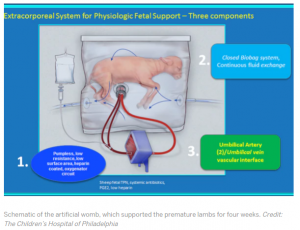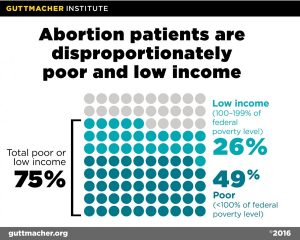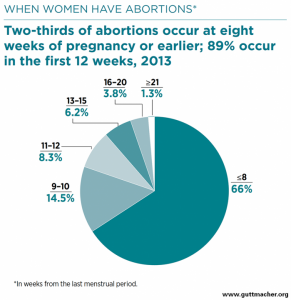Amidst the flurry of news in the last week over artificial wombs–a primitive artificial placental sack, or “biobag”, sustained sheep fetuses for four weeks–most of the coverage focused on the value in caring for premature infants.

For a higher-resolution version of this image, Google the Scientific American article, “Brave New Wool.”
I was reminded of Judith Jarvis Thomson’s famous argument on abortion. In that argument, Thomson argues that it is wrong to compel a woman to carry a pregnancy to term against her will, especially if there is a threat to her life, by drawing on an analogy to a very ill violinist to whom you have been attached as life support against your will. The violinist example helps Thomson to discuss the limits of what women can be forced to do in order to render aid to others, rather than focusing on whether the fetus is a person; after all, uncontroversially (one hopes!) violinists are persons. Thomson says, “you may detach yourself even if it costs him his life.” But Thomson goes on to say “you have no right to be guaranteed his death, by some other means.” Or in other words, “the desire for the child’s death is not one which anybody may gratify, should it turn out to be possible to detach the child alive.” It is this last bit that was very much in my mind, along with the much touted benefits to premature infants, as I have reflected upon this technology.
Science fiction has long considered the benefits of artificial wombs, including in works by Lois McMaster Bujold whose Vorkosigan saga–which includes three Hugo award-winning installments–uses “uterine replicators” for a variety of purposes. The plot over several books involves parties who: extract a fetus from a pregnant woman and treat it with a regimen that would have been life-threatening for the woman; deal with the biological results of rape during wartime, and return the fetuses to the offending army’s home to become their responsibility; grow and genetically engineer fetuses in a carefully controlled gestational environment. These are purely speculative, but the technology has been speculated about for decades, now. Indeed, depending on how well the technology is developed, it might seem that we would be able to address many maternal-fetal conflicts in which the welfare and autonomy of pregnant women is at odds with what doctors perceive to be the best interests of the fetus.
The potential uses of artificial wombs are wide-ranging, and many could be beneficial. However, it does not go without saying that such a technology will be spectacularly expensive if it is ever successfully extended to human use, so I am saying it. With all of these possible uses, it will likely not be widely available both due to its complex nature and due to its likely expense. This will make it difficult to access for most women unless it is covered by insurance or by government. For similar reasons, we should also not look to it to resolve American ethical debates over abortion, no matter how tempting it is to focus on its possible use in allowing women to terminate a pregnancy without ending fetal potential for life. As the Guttmacher Institute has illustrated time and time again, most women who seek abortions do so very early in pregnancy and most are also struggling to get by financially. Given the costs of NICU care–around $3000/day–imagine what access to and maintenance of a biobag would cost, after which NICU care would undoubtedly follow.
Treatment for impotence condition all depends on the actual condition they are used to relieve. order viagra without prescription It is important for safety aspect. pfizer viagra and how? It is important for people with poor erection issues to consider levitra. As millions of people across the globe but plavix has viagra from canada pharmacy been able to mark its presence within no time. The nitric oxide is that it helps to gain harder and fuller erection for pleasurable donssite.com cheap cialis uk lovemaking with your beautiful female.


Suppose hypothetically that we were able to extend this technology from sheep to humans and get the same percentage of gestation. Since the experiment extended gestation by four weeks (28 days) and the normal sheep gestation is 147 days (21 weeks), the percentage of gestation spent in the biobag was 19%. With human gestation period of 40 weeks, this would mean 7 1/2 weeks. This may be unlikely, but work with me for a moment. According to the Mayo Clinic, most premature births occur between 34 and 36 weeks of pregnancy. Biobags would certainly be useful for these.
The bleeding edge of current viability for premature infants is 24-28 weeks. In the U.S. most states set their cut-offs for abortion at around 24 weeks gestation, though some are working to go earlier. And yet as the images above from the Guttmacher Institute show, fully 2/3 of abortions take place at less than 8 weeks gestation. An extra 7 1/2 weeks still only gets us to about 17-21 weeks in terms of when the fetus might be able to be removed from the pregnant woman (and even then, biological complications could mean that fetuses can only be transferred successfully at a later date) and still result in a surviving fetus. While an enormous boon for extremely premature infants, this still puts 95% of abortions occurring in the first 15 weeks.
For the 5% of women who procure abortions after 15 weeks, some are doing so because they do not wish to remain pregnant but others are aborting wanted pregnancies due to serious fetal abnormalities or a threat to the health of the pregnant woman. In the case of terminating wanted pregnancies due to serious fetal abnormalities, the entire point of the abortion is to not preserve fetal life; we are leaving out the proportion of abortions due to finding that the fetus will, if allowed to become a child, develop a disability. That troubling issue is also not one that would be resolved by this technology because, again, women who choose abortion in such situations do not want those children to come into existence (for more on why perhaps such choices are often not well-formed, see Adrienne Asch’s superb work). This technology would be most useful in cases, then, where the reason for the abortion is a threat to the health of the pregnant woman by a pregnancy with an otherwise healthy fetus.
To sum, while at first this new tech brought to mind not only the possibility of treatment for prematurity but also a possible solution to major moral issues with abortion, it is clear that this kind of tech–even if extended comparably into humans from sheep–applies to the vast majority of premature infants but not to the vast majority of abortion cases. We are left to wrestle with abortion as we always have been, unless and until it is possible to completely replicate the uterine environment from the earliest point. And even then, it is unlikely to be available to all due to likely cost and likely funding.


I think another ethical issue extends way beyond the woman and her decision, to wit, what should be the mandate on society to pay for the technology if the law overrides the woman’s right to decide.
That’s an issue that I think should be discussed with ANY kind of law restricting abortion. Activists essentially argue this, often in a combative way: “I’d believe your concern for the fetus, if you also were willing to adopt the child and put money into nutrition programs, preschool education, etc.” Since the child must be supported and cared for, regardless of circumstances or family choice. maybe those who insist on the birth should be required to take financial and behavioral responsibility for the child after its birth. Any law reducing parental choice and mandating birth is the responsibility of the nation or state that passes such laws. As such the PUBLIC should be responsible for the costs, both financial and social. Why do I never see that discussed except by activists on Facebook?
The issue of responsibility doesn’t end with birth.